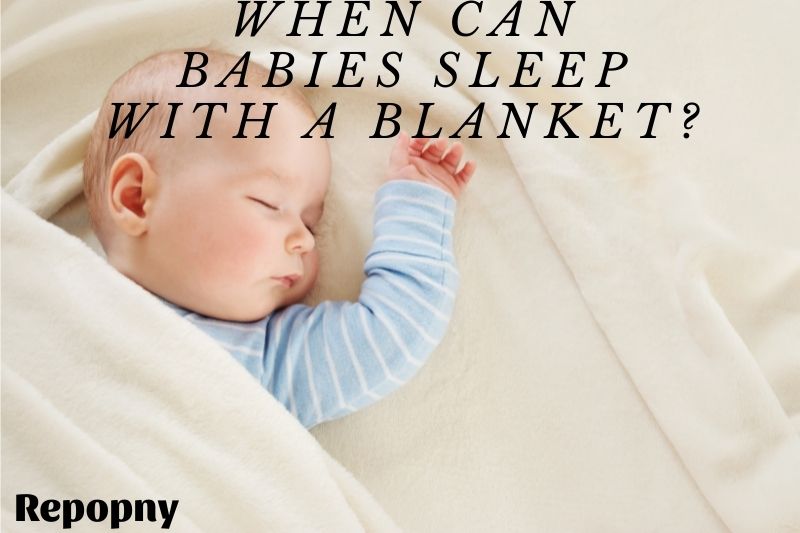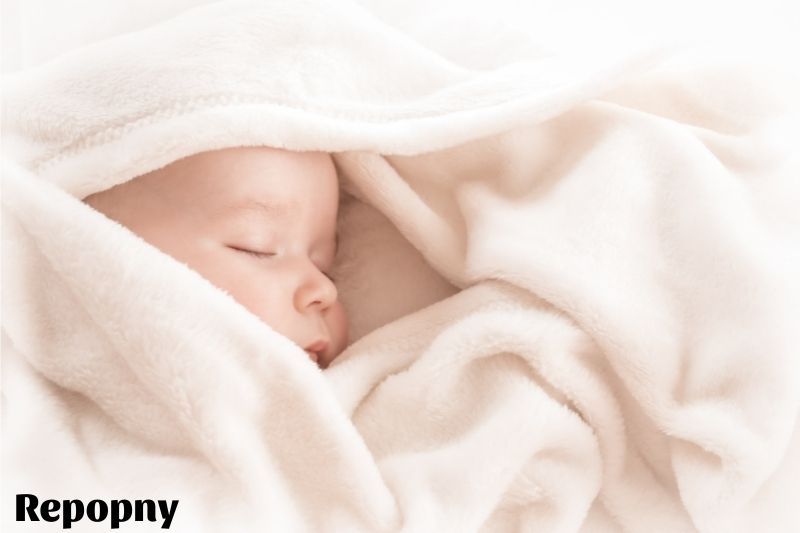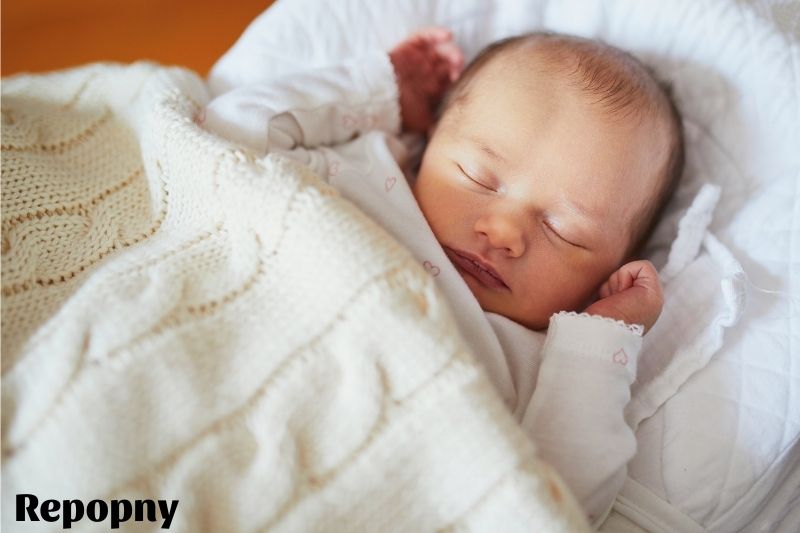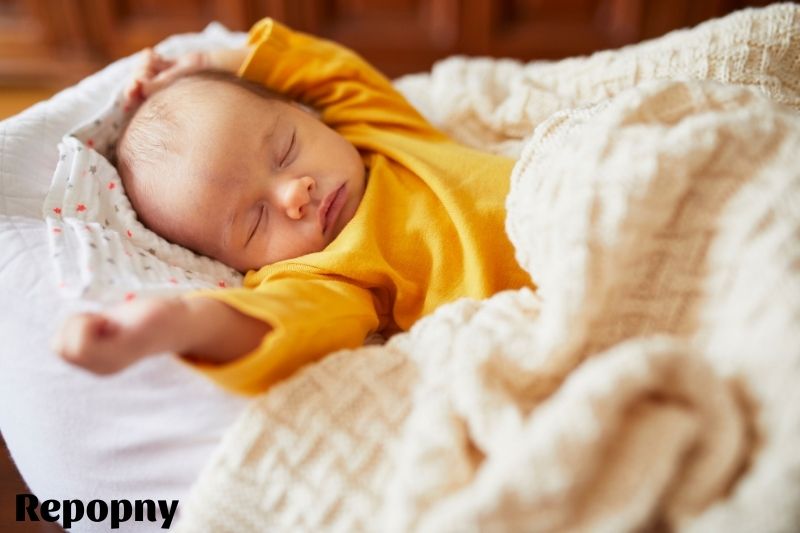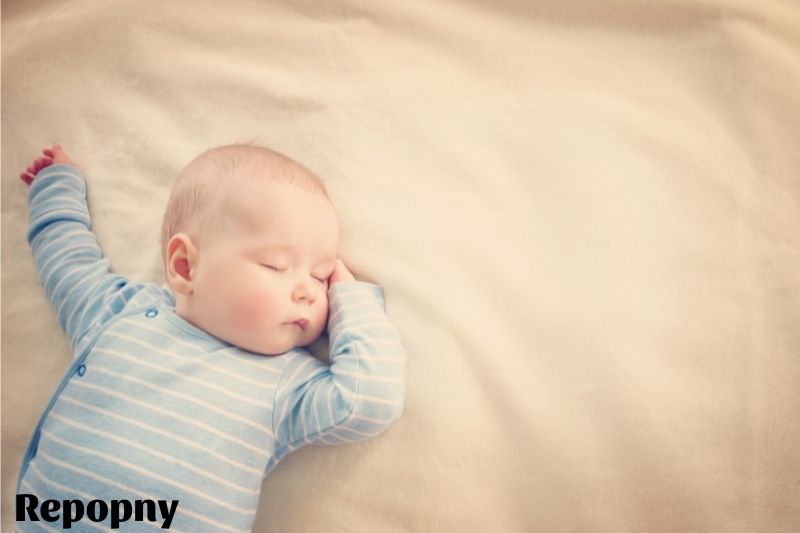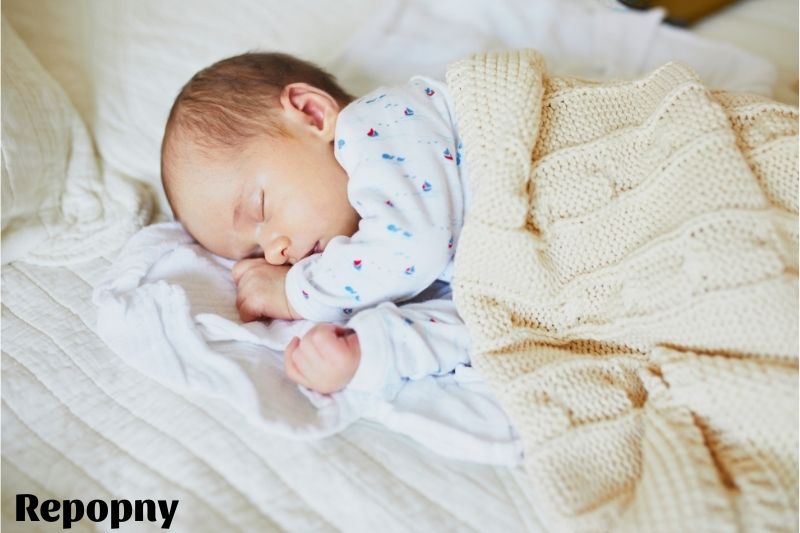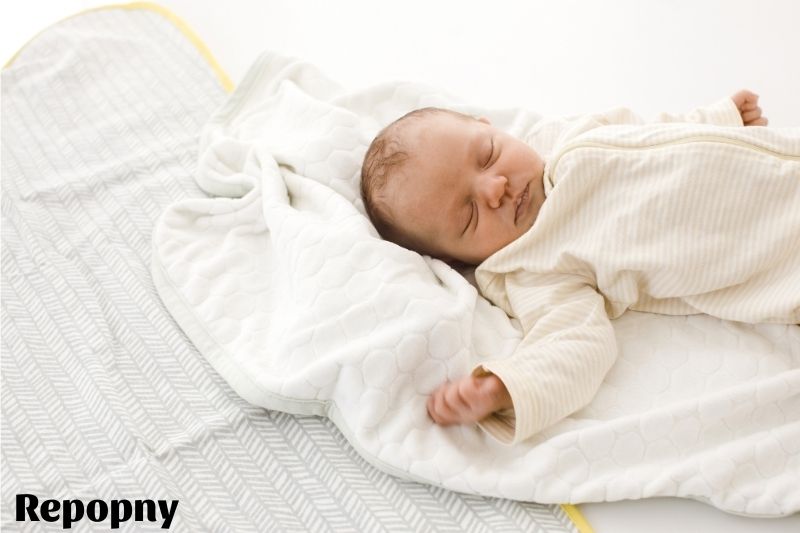- Repopny
Parents and experts have debated when can babies sleep with a blanket. There are many different opinions on the matter, and there is no one correct answer.
Some parents believe that it is safe to start using a blanket as soon as their baby can sit up on their own, while others believe it is best to wait until the baby is older.
We will explore the subject of baby blanket sleep and look at what the research says about this topic.
Contents
- 1 Are Blankets Safe For Babies To Sleep With?
- 2 Risks Of Putting A Blanket On A Baby Too Soon
- 3 Is Swaddling Better Than Loose Blankets For Babies?
- 4 Can A Baby Sleep With A Blanket When It’s Cold Outside?
- 5 How Can I Keep My Baby Warm If I Don’t Have a Blanket?
- 6 Baby Sleep Safety Recommendations
- 7 FAQs
- 8 Conclusion
Are Blankets Safe For Babies To Sleep With?
According to the American Academy of Pediatrics, sleeping with blankets is not safe for newborns under 12 months1.
In a nutshell, no, because blankets in the cot can be dangerous. Suffocation, trapping, or strangling are the most common causes of sudden infant death syndrome (SIDS) in this country, with blankets raising the risk of all four.
A bare crib, free of comforters, bumpers, cushions, fleece, sheepskin, and stuffed toys, is the safest sleep environment for a baby because they can suffocate under a blanket. In actuality, your infant merely requires a fitted sheet tucked in tightly on all sides at night.
Ads for positioners, wedges, special mattresses, or other surfaces that are advertised to minimize the risk of SIDS should be avoided since they have not been demonstrated to work, are possibly dangerous and should be avoided.
Risks Of Putting A Blanket On A Baby Too Soon
Sleeping with a blanket on your baby too early carries several concerns. The following are a few of the most prevalent.
Sudden Infant Death Syndrome (SIDS) is a type of premature infant (SIDS)
The most frightening aspect of SIDS is that there is no recognized cause—only a series of links between actions and adverse outcomes. According to the American Academy of Pediatrics, it’s advisable to avoid any recognized habits linked to SIDS, such as putting a cover in the crib too soon.2
Infant Death: Sudden and Unexpected (SUID)
The sudden and unexpected death due to natural or unnatural causes is referred to as SUID. One of the causes of SUID is SIDS. It denotes that the reason for death is unknown.
Accidental suffocation, trapping, and strangling are some scenarios that might result in SUID. Many causes of SUID are essentially preventable due to a clear link between sleep environment and newborn death.
Sleeping Problems
Transitioning to a blanket too soon when your baby becomes 12 months old can make going to bed and staying asleep more difficult. “When children can rely on long-term sleep associations, they learn to sleep well,” says Becker Freidman. “Whenever you adjust your child’s bedtime routine, sleep environment, or other sleep-related circumstance, expect some resistance.”
Fortunately, according to Becker Freidman, any sleep troubles that arise as a result of a move like switching from wearable blankets to a standard blanket should only be transitory. “Your good little sleeper will emerge as soon as you get past the transition stage,” she promises.
And, because blankets aren’t necessary, Dr. Murray believes it’s okay to skip them if they’re interfering with your child’s sleep.
Remember: There are no drawbacks to using a wearable blanket until toddlerhood, which is why, according to Becker Freidman, many parents wait until their child is in a big kid bed to transfer out of sleepsuits.
She claims that “wearable blankets are a safer alternative to a loose blanket.” “A wearable blanket can be a helpful sleep association and can also stop a determined crib climber from straddling the bars and climbing out of the crib.”
Overheating
Many people have problems sleeping when it’s too hot outside, including babies. “One reason kids experience night wakings or early morning wake-ups is overheating,” says Becker Freidman.
During the first year of life, it’s also a risk factor for SIDS. It’s why it’s not required to use your child’s favorite wearable blanket and a conventional blanket for warmth.
Is Swaddling Better Than Loose Blankets For Babies?
Swaddling is when a baby4 is wrapped tightly in a blanket for warmth and security, leaving only the child’s head exposed. Swaddling is a better option than blankets in the right circumstances, such as when your baby hasn’t tried to roll over.
This method can help the baby feel safe and secure without needing direct parental interaction and promote healthy sleep.
Sudden death is uncommon among swaddled babies. Parents who swaddle their babies should always put them to sleep on their backs. Due to the increased risk of suffocation when a baby sleeps on their tummy, parents should stop using a swaddle once the baby rolls over (or attempts to roll) at two months of age.
Some newborns may roll over before the two-month mark, so parents should stop swaddling as soon as they see the baby roll in any direction (even if only coming up on their side).
Can A Baby Sleep With A Blanket When It’s Cold Outside?
According to the American Academy of Pediatrics, it is not safe for a baby under the age of one year to sleep with a blanket. SIDS most commonly affects newborns between birth and six months6, but deaths can occur in infants as young as 12 months.
How Can I Keep My Baby Warm If I Don’t Have a Blanket?
There are a variety of techniques for parents to keep their sleeping babies at a comfortable temperature without using blankets.
Your Baby’s Clothes Should Be Layered
Instead of giving your infant a blanket, layer their garments for extra warmth during the night. To securely layer your baby’s sleepwear, don’t add more than one layer beyond what an adult would wear in the same weather.
Adjust The Temperature In Your Bedroom
In your baby’s room, set the temperature to between 68 and 72 degrees Fahrenheit7—babies who sleep through the night benefit from a comfortable resting temperature. Furthermore, overheating may raise the risk of SIDS, emphasizing the importance of maintaining a reasonable ambient temperature.
Wrap Your Baby In A Swaddle Or A Sleep Sack To Keep Them Warm
On cold evenings, swaddling your infant can provide extra warmth and make them feel safer. An asleep bag or wearable blanket, on the other hand, offers similar warmth and security but closes with a zipper. It’s crucial to make sure your baby’s sleep sack is the proper size so it doesn’t fall off or has extra fabric that could cause choking. Consider a swaddle or sleep sack as one piece of clothes if you’re layering. To avoid asphyxia, cease swaddling your infant soon as they start rolling in any way.
Baby Sleep Safety Recommendations
Parents can encourage bedtime safety by following other rules and waiting until a baby is one year old to introduce sleeping with a blanket.
Always Put Your Baby To Sleep On Their Back
You should always put your baby on their back for naps and nighttime sleep until 12 months old. As part of average growth, they may begin to roll over on their own during sleep. Even during this time, make sure your infant sleeps on their back.
Place Your Baby In A Crib To Sleep
The safest place for your infant to sleep is in a crib or something comparable, such as a bassinet or bedside sleeper. Other pieces of furniture, such as couches and chairs, can be highly hazardous to infants. Car seats, carriers, swings, and strollers designed for babies are not suggested for use as regular sleeping sites.
If your infant falls asleep in one of these gadgets, move them as quickly as possible to a firm mattress. Parents may want to introduce a toddler bed as their child becomes older.
Use A Mattress That Is Firm Enough To Fit The Crib
In addition to reducing the risk of suffocation, using the best firm mattress in your baby’s cot can help keep temperatures down, offering a safe and comfortable sleeping environment.
Memory foam should not be used in the mattress since it can be overly soft or conforming, posing a safety problem. The firm mattress should also fit snugly in the crib, with no room between it and the walls.
Objects, Including Bedding, Should Be Kept Out Of The Crib
Ensure that your baby’s crib is clear of loose materials such as blankets, cushions, toys, and stuffed animals until 12 months old. These things enhance the risk of suffocating by accident. On the other hand, a pacifier is perfectly safe to give to your kid and may even lower the risk of SIDS.
Choosing a fitted sheet that fits securely on the cot mattress without bunching or falling loose is advisable. Blankets or bedding are sometimes wrongly believed to be safe if laid flat beneath the baby rather than being used to cover the baby. Aside from a fitted sheet, no other bedding should be in a baby’s crib while they sleep, no matter where it is positioned.
Do Not Allow Your Baby to Sleep in Your Bed Bed-sharing, or allowing your baby to sleep in your bed with you, might put your baby at risk of harm or asphyxia. Try room-sharing as an alternative.
While your baby is placed on a different surface, such as a cot or bassinet, sleeping in the same room with them helps decrease these hazards while still allowing parents to monitor their baby’s needs. Room-sharing for a baby’s first 6-12 months of life is suggested since it can reduce the incidence of SIDS by up to 50%.
Establish A Regular Bedtime Routine
Early childhood development depends on sleep, and maintaining a consistent bedtime routine8 improves good overall sleep health.
Consistent pre-sleep rituals, such as reading a book, singing lullabies, cuddling with your child, or bathing them, can help babies distinguish between night and day and prepare them to fall off each night. To create a pleasant link with the experience, it is also vital to teach proper sleep habits early in life and model healthy sleep patterns.
FAQs
Is it okay for my 18-month-old to sleep with a blanket?
It’s okay for your youngster to sleep with a thin blanket or lovey once he reaches the age of 18 months. If he’s in a crib, though, make sure the blanket and stuffed animal aren’t big enough for him to use to climb over the side.
Is it possible for a toddler to wake up if they are cold?
If your child wakes up between 3 and 4 a.m., they are likely cold. When it comes to the cold, two factors work against young children: they have trouble controlling their body temperature, which means they can get hot or cold very rapidly.
What is the best way to introduce a blanket to a toddler?
To properly introduce a blanket into the bed, the infant must have complete head control and the ability to roll over. Baby blankets should not be provided until the following criteria have been met: The child has turned one year old.
Conclusion
Most parents don’t give much thought to when their babies can start sleeping with a blanket. After all, it’s just a piece of fabric. But the truth is that blankets can pose a severe safety risk for babies, and it’s essential to know when they can start using them.
According to the American Academy of Pediatrics, babies should not sleep with blankets until they are 12 months old. Repopny hopes This article has helped you with your questions about when can your baby sleep with a blanket at night.
